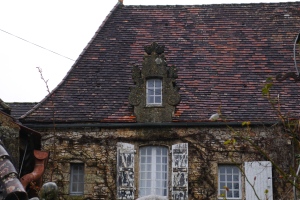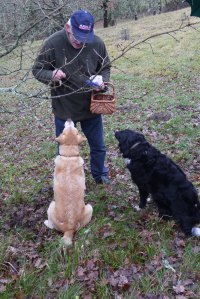Heading for la Truffiere de Péchalifour to meet up with Monsieur Aynaud at his truffle farm, we needed Doris the navigator programmed with precise GPS co-ordinates to successfully direct us into the wooded countryside. Péchalifour is just a tiny cluster of houses; the stone buildings are steeped with old-world bucolic charm and in the midst of the beautiful Périgord countryside made a picturesque sight even on the cold wet day we were there. It would be the perfect setting for an historical novel, and while it’s only a few miles from St Cyprien, it’s remote enough that without Doris’ navigational skills (and in light of our previous day’s experience) it could easily have been the setting for a crime novel.
We first met Edouard (Monsieur Aynaud), our expert truffle guide, at a regional food producers’ exposition in Montmartre last year; we got chatting about truffles, then it emerged he had been to NZ to advise truffle growers setting up their operations there, and so, like truffles themselves the seed was sown about making a visit to go truffle hunting.
After a very animated (he is French after all) and informative introduction to the history and science of truffle cultivation our 30-strong posse of expectant truffle hunters set out with Monsieur Aynaud directing his enthusiastic truffle hunting dogs; Farah a busy border collie and Titeuf the semi-retired golden Labrador.
Farah followed her instructions impeccably (“cherche Farah, cherche; elle est où?”), sniffing out the truffles with 100% accuracy, her olfactory radar system finely tuned to the aromatic black balls of fungus. (The truffle is actually the fruiting body of a fungus in the Ascomycetes family that grows by wrapping its spreading fibres onto the root system of oak and nut trees benefiting both the tree and the fungus.)
Farah is fully tuned in to the pay-for-performance system in operation, and sits close by her master as soon as she’s done her job to wait for her little treat. Occasionally she tries to help with a bit more digging if the human truffle hunter is not proving as adept at recovery as Farah would like. She’s recalled to sit with a reminder that “he will find it” and once the truffle is carefully dug up with the special digging tool or bare hands she gets her reward.
After a thoroughly entertaining hour of sniffing and digging there was a good haul of walnut sized truffles in the basket. These truffles are the black Périgord variety. Summer truffles also grow here; the highly prized white truffles grow in Italy. Amongst the multitude of interesting facts and figures about truffles, Monsieur Aynaud also told us how to store our truffles and serve them.
So, backed up with the handy hints from our homestay host Murielle I’ve now made a couple of sausage shaped tubes of truffle butter with about half the truffle we bought at the market in Sarlat. The butter will rest in the fridge for 2 or 3 days to allow the truffle flavour to infuse completely before it goes in the freezer from where I can take it out as required to serve on toast, in mashed potatoes, or with pasta. The rest of the truffle is in an airtight container in the fridge along with some eggs to let the flavour permeate and I’ll use these to make truffle flavoured scrambled eggs later in the week. Bon appétit.











